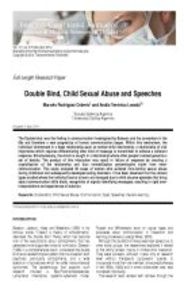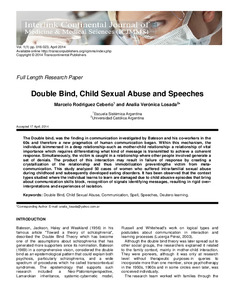Por favor, use este identificador para citar o enlazar este ítem:
https://repositorio.uca.edu.ar/handle/123456789/6211| Campo DC | Valor | Lengua/Idioma |
|---|---|---|
| dc.contributor.author | Rodríguez Ceberio, Marcelo | es |
| dc.contributor.author | Losada, Analía Verónica | es |
| dc.contributor.other | Escuela Sistémica Argentina | es |
| dc.contributor.other | Universidad Católica Argentina | es |
| dc.date.accessioned | 2019-06-12T01:38:50Z | - |
| dc.date.available | 2019-06-12T01:38:50Z | - |
| dc.date.issued | 2014 | - |
| dc.identifier.citation | Rodríguez Cebeiro, M. y Losada, A. V. (2014,abril). Double bind, child sexual abuse and speeches [en línea]. ICJMMS, 1(1). http://transconpublishers.org/icjmms/index.php. Registro disponible en: https://repositorio.uca.edu.ar/handle/123456789/6211 | es |
| dc.identifier.uri | https://repositorio.uca.edu.ar/handle/123456789/6211 | - |
| dc.description.abstract | Abstract: The Double bind, was the finding in communication investigated by Bateson and his co-workers in the 60s and therefore a new pragmatics of human communication began. Within this mechanism, the individual isimmersed in a deep relationship–such as mother-child relationship- a relationship of vital importance which requires differentiating what kind of message is transmitted to achieve a coherent response. Simultaneously, the victim is caught in a relationship where other people involved generate a set of denials. The product of this interaction may result in failure of response by creating a crystallization of the relationship and thus immobilization preventingthe victim from metacommunication. This study analyzed 50 cases of women who suffered intra-familial sexual abuse during childhood and subsequently developed eating disorders. It has been observed that the context types studied where the individual learns to learn are damaged due to child abusive episodes that bring about communication skills block, recognition of signals identifying messages, resulting in rigid overinterpretations and experiences of isolation | es |
| dc.format | application/pdf | es |
| dc.language.iso | eng | es |
| dc.rights | Acceso Abierto | es |
| dc.rights.uri | https://creativecommons.org/licenses/by-nc-sa/4.0/ | es |
| dc.source | Interlink Continental Journal of Medicine & Medical Sciences, Vol.1(1), 2014 | es |
| dc.subject | ABUSO SEXUAL | es |
| dc.subject | ABUSO INFANTIL | es |
| dc.subject | RELACIONES FAMILIARES | es |
| dc.subject | COMUNICACION HUMANA | es |
| dc.subject | TRASTORNOS DE LA ALIMENTACION | es |
| dc.subject | MUJERES | es |
| dc.title | Double bind, child sexual abuse and speeches | es |
| dc.type | Artículo | es |
| uca.path | Facultad de Psicología y Psicopedagogía|Artículos | es |
| uca.disciplina | PSICOLOGIA | es |
| uca.filename | /home/data-uca-generic/folder_generic_common/articulos/double-bind-child-sexual/metadata.xml | es |
| uca.issnrd | 1 | es |
| uca.affiliation | Fil: Rodríguez Ceberio, Marcelo. Escuela Sistémica Argentina; Argentina | es |
| uca.affiliation | Fil: Losada, Analía Verónica. Pontificia Universidad Católica Argentina; Argentina | es |
| uca.version | publishedVersion | es |
| item.grantfulltext | open | - |
| item.fulltext | With Fulltext | - |
| item.languageiso639-1 | en | - |
| crisitem.author.orcid | 0000-0003-0488-4651 | - |
| Aparece en las colecciones: | Artículos | |
Ficheros en este ítem:
| Fichero | Descripción | Tamaño | Formato | |
|---|---|---|---|---|
| double-bind-child-sexual.jpg | 7,65 kB | JPEG |  Visualizar/Abrir | |
| double-bind-child-sexual.pdf | 150,44 kB | Adobe PDF |  Visualizar/Abrir |
Visualizaciones de página(s)
218
comprobado en 30-abr-2024
Descarga(s)
180
comprobado en 30-abr-2024
Google ScholarTM
Ver en Google Scholar
Este ítem está sujeto a una Licencia Creative Commons

